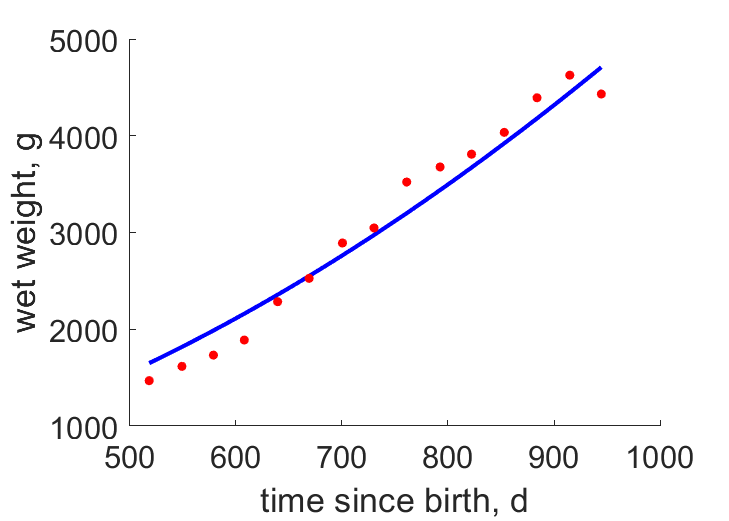Predictions & Data for this entry
| Model: std | climate: Af | migrate: | phylum: |
| COMPLETE = 2.5 | ecozone: TPi | food: bpCvr, biCvm, biSv | class: |
| MRE = 0.070 | habitat: 0iTh, 0iTf | gender: Dg | order: |
| SMSE = 0.011 | embryo: Tt | reprod: O, Apa | family: |
Zero-variate data
| Data | Observed | Predicted | (RE) | Unit | Description | Reference |
|---|---|---|---|---|---|---|
| ab | 49 | 51.7 | (0.05513) | d | age at birth | AnAge |
| ap | 1612 | 1788 | (0.1089) | d | age at puberty for females | WalsChis2002, AnAge |
| apm | 2920 | 2920 | (2.417e-05) | d | age at puberty for males | Kerk2010 |
| am | 2.263e+04 | 2.263e+04 | (3.488e-05) | d | life span | AnAge |
| Lb | 40 | 32.91 | (0.1773) | cm | total length at birth | WalsChis2002 |
| Lp | 200 | 187.9 | (0.06065) | cm | total length at puberty | WalsChis2002 |
| Li | 240 | 313.4 | (0.3057) | cm | ultimate total length | WalsChis2002 |
| Wwb | 90 | 93.13 | (0.03478) | g | wet weight at birth | WalsChis2002, LemmEdwa2004 |
| Wwp | 1.8e+04 | 1.733e+04 | (0.03744) | g | wet weight at puberty | WalsChis2002, BircWals1995 |
| Wwi | 8.7e+04 | 8.04e+04 | (0.07583) | g | ultimate wet weight for female | AnAge |
| Wwim | 7e+04 | 7e+04 | (1.648e-05) | g | ultimate wet weight for male | Kerk2010 |
| Ri | 0.06027 | 0.06039 | (0.001907) | #/d | maximum reprod rate | Sunt2008, AnAge |
Uni- and bivariate data
| Data | Figure | Independent variable | Dependent variable | (RE) | Reference |
|---|---|---|---|---|---|
| tW |  | time since birth | wet weight | (0.05856) | LemmEdwa2002 |
Pseudo-data at Tref = 20°C
| Data | Generalised animal | Varanus komodoensis | Unit | Description |
|---|---|---|---|---|
| v | 0.02 | 0.128 | cm/d | energy conductance |
| kap | 0.8 | 0.9712 | - | allocation fraction to soma |
| kap_R | 0.95 | 0.95 | - | reproduction efficiency |
| p_M | 18 | 17.1 | J/d.cm^3 | vol-spec som maint |
| k_J | 0.002 | 0.002 | 1/d | maturity maint rate coefficient |
| kap_G | 0.8 | 0.7975 | - | growth efficiency |
Discussion
- Species data from pers comm. Don Boyer (curator of herpetology, Bronx Zoo)and Steve Conners curator of herpetology, Miami metro zoo)
- Data obtained from Flores V. komodoensis population that are likely to have different life-history to island populations on Komodo or Rinca Island.
- All data from captive specimens and corresponding parameters for wild specimens lacking with exception for some growth information contained within LavePurw2012
- Males are assumed to differ from females by {p_Am} and E_Hp only
- mod_2: tW data added
Facts
- Zoological institution study books provide life-history information from captive specimens (Ref: Koor2009, Blijdorp, San_Diego)
- Juvenile lives 3 till 4 yr in trees to avoid predation by adults (Ref: Kerk2010)
Bibliography